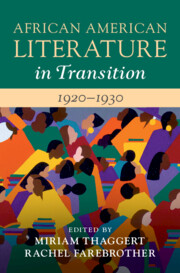Book contents
- African American Literature in Transition, 1920–1930
- African American Literature in Transition
- African American Literature in Transition, 1920–1930
- Copyright page
- Contents
- Illustrations
- Contributors
- Acknowledgments
- Chronology of Historical Events, People, and Publications, 1920–1930
- Preface
- Introduction
- Part I Habitus, Sound, Fashion
- Chapter 1 New Negro Literary Décor
- Chapter 2 The New Negro Movement’s Recording Imaginary
- Chapter 3 Sartorial Self-Fashioning in the Harlem Renaissance
- Part II Space
- Part III Uplift Renewed
- Part IV Serial Reading
- Bibliography
- Index
Chapter 1 - New Negro Literary Décor
Competing Tastes in the 1920s
from Part I - Habitus, Sound, Fashion
Published online by Cambridge University Press: 17 March 2022
- African American Literature in Transition, 1920–1930
- African American Literature in Transition
- African American Literature in Transition, 1920–1930
- Copyright page
- Contents
- Illustrations
- Contributors
- Acknowledgments
- Chronology of Historical Events, People, and Publications, 1920–1930
- Preface
- Introduction
- Part I Habitus, Sound, Fashion
- Chapter 1 New Negro Literary Décor
- Chapter 2 The New Negro Movement’s Recording Imaginary
- Chapter 3 Sartorial Self-Fashioning in the Harlem Renaissance
- Part II Space
- Part III Uplift Renewed
- Part IV Serial Reading
- Bibliography
- Index
Summary
Cherene Sherrard-Johnson explores the social and private spaces of the New Negro movement to delineate the subjective but recognizable element of taste. The chapter reads spaces such as the salon, the parlor, and the cabaret in order to define the aesthetic considerations of the period. The interior design of such locales offers a new way of understanding the period outside of the Black/white binary and simplistic assumptions about the black bourgeoisie. Readers can discern a great deal about New Negro style by focusing on "the spatially attentive narratives of the storied interiors of the Harlem Renaissance." Reading Edward Christopher Williams’s The Letters of Davy Carr, Jean Toomer’s play Natalie Mann, as well as descriptions of important salon spaces such as Villa Lewaro, Sherrard-Johnson analyzes how the objects and accoutrements within certain spaces reflect the aesthetic debates of the New Negro period.
Keywords
- Type
- Chapter
- Information
- African American Literature in Transition, 1920–1930 , pp. 19 - 45Publisher: Cambridge University PressPrint publication year: 2022

